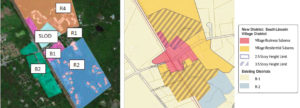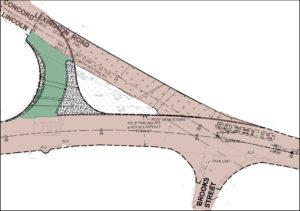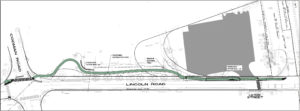(Editor’s note: when this story was originally published, the accompanying map misidentified the amount of land that would be subject to multifamily zoning under the new state rules. The map has been updated.)
To comply with new state housing guidelines, Lincoln would have to allow 750 units in South Lincoln or become ineligible for various state grants.
Because it has a commuter rail station, Lincoln is designated as an “MBTA community” and is therefore required to amend its zoning to allow multifamily housing with half a mile of the station or face loss of eligibility for some state grants. The rules call for a minimum of 15 units per acre suitable for families and children and with no age restrictions. This translates to 750 units for Lincoln.
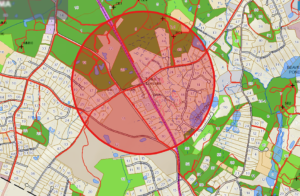
The red circle shows land within a half-mile radius of the Lincoln commuter rail station. Wetlands and buffers are indicated in shades of blue, conservation land is in green, and the beige area in the southwest quadrant is the Mass Audubon Society. The town would have to allow 750 units of multifamily housing within that area to comply with the Housing Choice Act. NOTE: this map was incorrect when initially published and was updated on Jan. 19, 2022. (Map courtesy Margaret Olson)
The initiative was announced in early 2021 but the initial outline of the law left many unanswered questions.
“We verified this [750-unit requirement] jaw-dropper with the state,” Planning Board Chair Margaret Olson, who made an illustration of “just how infeasible this is.” At least half of the acreage within that zone is wetlands, wetlands buffer, or conservation land, she noted.
It’s unclear how the existing multifamily units in South Lincoln would be counted as part of Lincoln’s requirement. Condos and apartments with half a mile of the station include 125 units in Lincoln Woods and a total of 65 units in three developments on Ridge Road and Greenridge Lane.
There will be a webinar hosted by the state Executive Office of Housing and Economic Development to explain the requirements outlined in a 2021 bill on Wednesday, Jan. 12 at 1 p.m. Click here to register.
If Lincoln does not comply by changing its zoning, it would no longer be eligible for grants from the Housing Choice Initiative, the Local Capital Projects Fund, or the MassWorks infrastructure program. It’s unclear how much money Lincoln has received from these funds in the past.

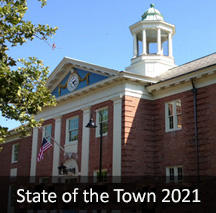

 The first phase of an engineering study of the wastewater treatment plant near the mall shows that it’s working well and has additional capacity to handle some commercial or residential development in the area.
The first phase of an engineering study of the wastewater treatment plant near the mall shows that it’s working well and has additional capacity to handle some commercial or residential development in the area.